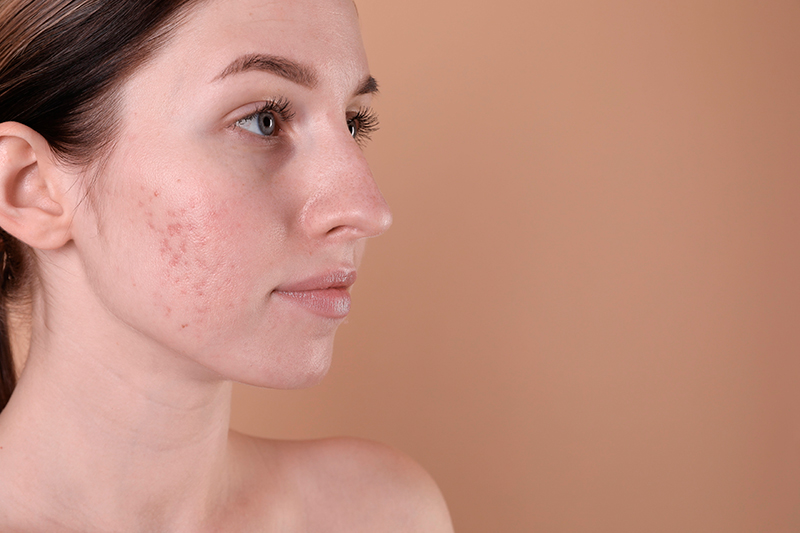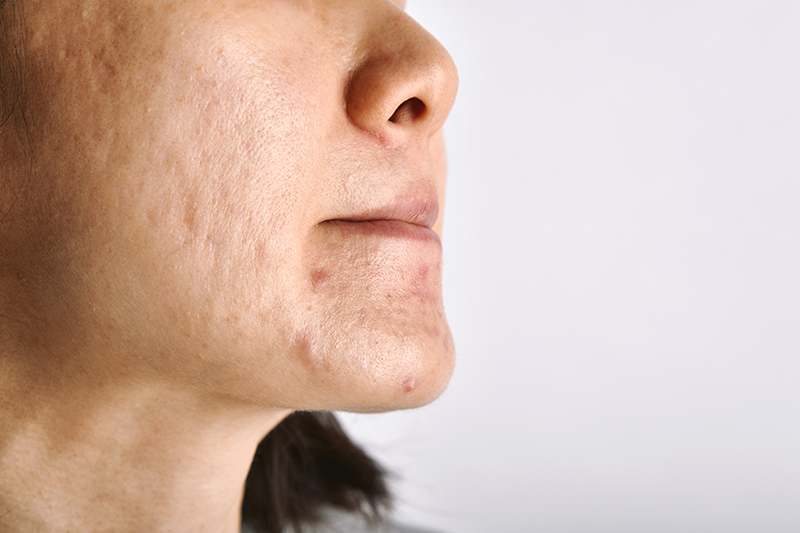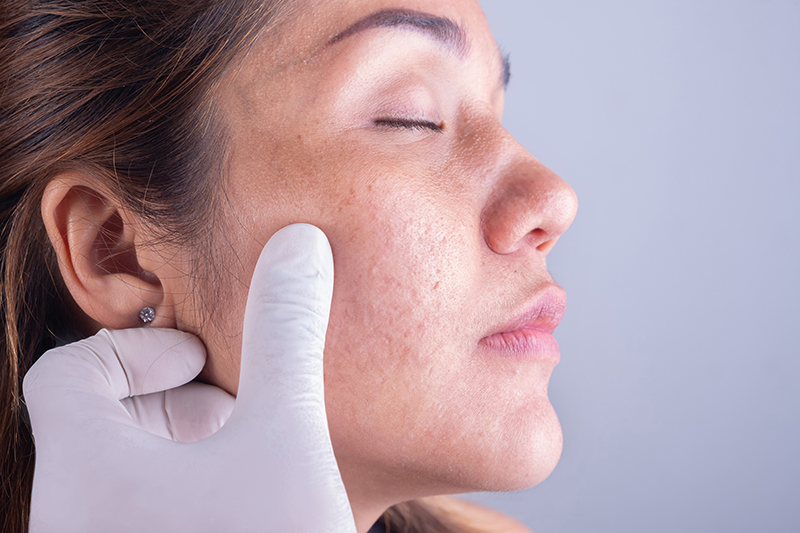Aknearvet

Aknearvet ovat pysyviä jälkiä, jotka voivat jäädä iholle aknen parantuessa. Akne itsessään on ihosairaus, jossa talirauhaset tukkeutuvat ja tulehtuvat, mikä johtaa erilaisiin ihon muutoksiin, kuten punaisiin näppylöihin, mustapäihin ja kystisten paukamien muodostumiseen. Aknearvet syntyvät, kun tulehdus vaikuttaa syvemmälle ihoon, vaurioittaen ihon kudosta ja häiritsemällä sen normaalia paranemisprosessia. Vaikka aknea esiintyy yleensä teini-ikäisillä ja nuorilla aikuisilla, se voi jäädä vaivaksi myös pidemmälle aikuisuuteen, erityisesti hormonaalisten muutosten, kuten raskauden tai vaihdevuosien myötä.
Aknearvet eivät ole vain esteettinen ongelma, vaan ne voivat myös vaikuttaa psyykkiseen hyvinvointiin. Arpien hoito onkin tärkeä osa aknen kokonaisvaltaista hoitoa, sillä oikea-aikainen ja tehokas hoito voi estää arpeutumisen pahenemisen ja nopeuttaa ihon paranemista. Kystinen akne, joka on erityisen syvä ja tulehduksellinen aknen muoto, on erityisen altis arpeutumiselle. Samoin hormonaalinen akne voi johtaa myös vaikeampiin aknearpiin.
Mistä aknearvet johtuvat?
Aknearvet syntyvät, kun aknen aiheuttamat tulehdukset ja ihon vauriot paranevat epätasaisesti. Jos tulehdus on vakava ja ulottuu syvälle ihoon, se voi vahingoittaa ihon kerroksia ja aiheuttaa arpikudoksen syntymistä. Arpeutumisprosessi voi kestää pitkään ja siihen vaikuttavat muun muassa perinnölliset tekijät, ihon paranemisnopeus ja tulehdusaste aknen aikana.
Erityisesti aknen vakavammat muodot, kuten kystinen akne ja hormonaalinen akne, voivat johtaa syvempiin ja pysyvämpiin arpiin. Kystinen akne on syvä, kivulias ja laaja-alainen tulehdus, joka voi johtaa suuriin vaurioihin ihon kudoksessa. Hormonaaliset muutokset, kuten ne, joita esiintyy teini-iässä, voivat myös altistaa aknelle ja sen arpeutumiselle. Esimerkiksi naisilla hormonit voivat vaihdella kuukautiskierron, raskauden tai vaihdevuosien aikana, mikä voi vaikuttaa talinerityksen määrään ja altistaa ihon akneongelmille.
Aknearpiin voivat vaikuttaa myös ympäristötekijät ja elintavat. Esimerkiksi stressi, huonot ruokailutottumukset tai tupakointi voivat pahentaa aknea ja estää arpeutuneen ihon paranemista. Lääkkeet, kuten kortikosteroidit, voivat myös lisätä arpeutumisen riskiä, sillä ne heikentävät ihon kykyä parantua normaalisti. Ihon hoito, kuten liian kovakouraiset puhdistus- tai puristusyritykset, voivat myös vaurioittaa ihoa ja edistää arpeutumista.
Aknearpiin vaikuttavat siis monet tekijät ja niiden syntymisen estäminen vaatii kokonaisvaltaista lähestymistapaa aknen hoidossa.

Aknearpien muodot ja vaiheet
Aknearvet voivat esiintyä eri muodoissa ja vaihtelevissa vakavuusasteissa, jotka määräytyvät sen mukaan, kuinka voimakas aknen aiheuttama tulehdus on ollut ja kuinka iho on kyennyt toipumaan vauriosta. Yleisimmät aknearpien tyypit ovat atrofiset ja hypertrofiset arvet.
Atrofiset arvet ovat yleisimpiä ja syntyvät silloin, kun iho ei tuota tarpeeksi kollageenia vaurion korjaamiseksi. Tämä johtaa kuoppiin tai painaumiin ihossa. Atrofisia arpia on kolmea päätyyppiä: “ice pick” -arvet, jotka ovat pieniä ja syviä, “boxcar” -arvet, jotka ovat kulmikkaita ja matalampia, sekä “rolling” -arvet, jotka ovat pyöreitä ja pinnallisia. Näiden arpien hoitaminen voi olla haastavaa, mutta ne voivat parantua ajan kanssa, kun ihon palautumista stimuloidaan oikeilla hoitomenetelmillä.
Hypertrofiset arvet, toisin sanoen koholla olevat arvet, syntyvät silloin, kun ihon parantuessa syntyy liikaa kollageenia. Tämä voi aiheuttaa paksuja, punaisia tai vaaleita arpia, jotka erottuvat ihon pinnalta. Hypertrofiset arvet voivat jäädä näkyviin pitkäksi aikaa ja voivat jopa levitä aknen tulehduksen ympärille. Keloidiarvet ovat erityinen hypertrofisten arpien alaryhmä ja ne voivat olla suuria, paksuja ja niiden kasvu voi ylittää alkuperäisen vaurion alueen. Keloidien hoito on usein erityisen haastavaa ja vaatii erikoishoitoja.
Arpien kehittyminen tapahtuu yleensä aknen parantuessa, mutta vaurioitunut iho ei aina parane täysin tasaisesti. Ensimmäinen vaihe on aknen tulehdus ja sen synnyttämä kudosvaurio. Tämän jälkeen tulehdus alkaa laskea ja iho alkaa korjaantua, mutta arpeutumisprosessi on pitkä. Arpien muodostuminen voi kestää kuukausia tai jopa vuosia ja ihon uusiutumisen aikana voivat tummat tai vaaleat jäljet jäädä näkyviin.

Miten aknearpia voi hoitaa?
Aknen hoito on tärkeä osa aknearpien ehkäisyä ja vähentämistä. Hyvin hoidettu akne voi estää arpeutumisen ja vähentää jälkiseurauksia. Mikäli aknearvet ovat jo kehittyneet, niihin voidaan kuitenkin vaikuttaa erilaisilla hoitomenetelmillä, jotka parantavat ihon ulkonäköä ja stimuloivat sen uudistumista:
- EXION Clear RF: Häivyttää aknearpia ohjaamalla RF-energiaa mikroablaation avulla ihon pintakerrokseen, mikä poistaa vaurioitunutta ihoa ja käynnistää ihon luonnollisen uusiutumisprosessin sekä pintarakenteen tasoittumisen.
- EXION Fractional RF: RF mikroneulauksessa neulojen ja radioaaltojen yhdistelmä stimuloi kollageenin tuotantoa ja parantaa ihon rakennetta. Menetelmä pienentää huokosia ja parantaa ihon tasaisuutta.
- Täyteaineet: Täyteaineet voivat auttaa aknearpien hoidossa täyttämällä ihon kuoppaumia sisältäpäin, jolloin arvet tasoittuvat ja ihon pinta näyttää sileämmältä ja tasaisemmalta heti hoidon jälkeen.
- PRP-hoito ja PRP-hyaluronihappohoito: PRP-hoidossa käytetään potilaan omaa veriplasmaa, joka on runsas kasvutekijöistä, stimuloimaan ihon uusiutumista, lisäämään kollageenin tuotantoa ja parantamaan napakkuutta. Kun hoito yhdistetään hyaluronihappoon, se tarjoaa lisäksi voimakasta kosteutusta, parantaa elastisuutta ja rakennetta, tasoittaa arpia ja tekee ihosta terveemmän ja paremman näköisen.
- Mesoterapia ja biorevitalisaatio: Hoidot vievät ihoa uudistavia, kirkastavia ja syväkosteuttavia vaikuttavia aineita, mukaan lukien puhdasta hyaluronihappoa, suoraan ihoon. Ne stimuloivat solujen uusiutumista, aktivoivat ihon luonnollisen korjausprosessin, parantavat rakennetta ja elastisuutta sekä vähitellen tasoittavat aknearpia.
- Botuliini: Botox-hoito voi huomattavasti pehmentää postaknearpien näkyvyyttä kasvojen ilmeikkäillä alueilla, kuten otsassa, kulmien välissä tai leuassa. Rentouttamalla ympäröiviä lihaksia botox vähentää ihon jännitystä, mikä auttaa tekemään atrofisista tai hypertrofisista arvista vähemmän näkyviä.
- Laserhoidot: Laserhoito käyttää valoa ihon kerrosten läpi parantaakseen arpia, vähentäen niiden näkyvyyttä ja edistäen ihon tasoittumista.
- Kemialliset kuorinnat: Kemiallisessa kuorinnassa käytetään hapon ja entsyymien seoksia, jotka kuorivat ihon pintakerroksen ja stimuloivat kollageenin tuotantoa. Tämä on täydentävä menetelmä, joka on tehokas postaknepigmentaatioon.
- AHA- ja BHA-tuotteet: AHA (alpha hydroxy acid) ja BHA (beta hydroxy acid) hoitotuotteet auttavat kuorimaan ihoa ja vähentävät arpien tummuutta ja epätasaisuutta. Nämä tuotteet ovat tehokkaita postaknepigmentaatioon ja suositellaan osaksi kotihoitorutiinia.
MESQ®
DoctusPlus Oy:n aputoiminimi
Yritys
DoctusPlus Oy
Y-tunnus
3154088-6
Käyntiosoite
Itämerenkatu 11-13 F, 00180 Helsinki
Puhelin
Sähköposti
Aukioloajat
Ma – Pe 11:00 – 19:00